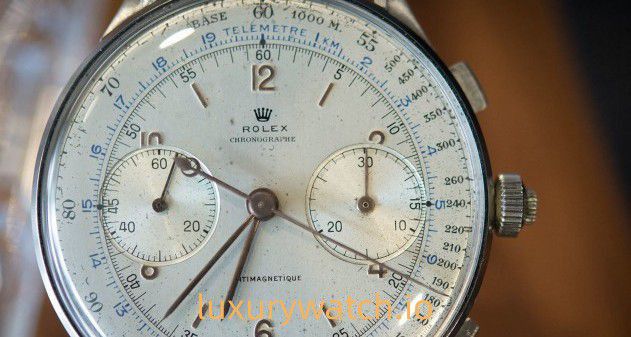Luxury Replica Watches
A Detailed Explanation Of Double Rattrapante Timing Summary, Rolex Replica
What is the highest level of complexity? Some people swear by the minute repeater; others have different opinions on the tourbillon, and watch fans all have different opinions. However, in the field of chronographs, neither standard chronograph nor flyback chronograph can challenge or even shake the supremacy of split-seconds/rattrapante chronograph.

Rolex Ref.4113 split-seconds chronograph
The distinctive feature of the split-second clock is that it is equipped with two-second hands (different from the one of ordinary chronographs), usually decorated with a hollow ring at the end and the other with a solid tip. The split-second chronograph is lovable, not only because of its unique complex beauty but also because of its exciting and fun mechanism. At the “Start-Stop-Reset” themed auction held by Phillips in Geneva in May 2016, the Rolex 4113 split-second chronograph sold for 2.4 million Swiss francs. What exactly is this watch? What’s so special about it? This article will summarize and introduce double split-second chronographs, especially antique models. Rolex replica.
Why are two seconds hands better than one?
First, what is the double rattrapante mechanism, and why do we need two chronograph hands? If it is an ordinary clock, when the chronograph function is started, a long second hand begins to record the running time; the long second hand rotates once, and the minute chronograph hand (usually set at the 3 o’clock position on the dial) advances one space, and then the long second-hand starts to record the second minutes running time. But what if you want to time an intermediate event accurately, such as a horse racing lap time while recording the overall running time? One method uses two or three clocks, starting simultaneously and stopping as needed.
The split-second mechanism allows you to do just that, using only one clock. Starting the split-second chronograph activates two hands at the same time. When the first event occurs, pressing the button stops one hand (usually the solid-tipped one) while the other hand continues to move. Record the time and press the button again; the stopped hand will “catch up” with the running hand, and the operation can be repeated. When started, the second hands overlap; when one is stopped, the second hands “split,” which is also the origin of the name of the Split-Seconds chronograph.

Patek Philippe’s split-second chronograph
This mechanism first appeared in pocket watches in the 1880s. In 1932, Patek Philippe launched its first double split-second chronograph watch with a diameter of 30 mm, a single button (matched with the crown), and an enamel dial. In 1999, it sold for US$3 million at the Antiquorum auction. However, most split-second chronograph movement blanks were made by Valjoux or Venus in the mid-20th century. Patek Philippe replica.
Understand the traditional split-second timing mechanism.
The double split-second chronograph mechanism used in Venus movements is the most common. The central gear has unique tines on both sides. This is the clamp jaw, which we will discuss later. From the 1940s to the 1950s, Venus movements were supplied to brands such as Breitling and RecordWatchCo. Shortly after, these movements were discontinued.
Note that the movement is equipped with two central gears – the upper gear is connected to the rattrapante seconds hand (i.e., solid tip seconds hand), and the lower gear is connected to the central chronograph seconds hand (i.e., hollow ring seconds hand). The rattrapante second’s hand functions via a set of levers that form the clamp’s jaws. The upper gear is mechanically connected to the lower gear with the help of spring levers and ruby rollers.

Venus185 double split-second chronograph movement
Press the “Separate” button, and the clamp jaws come together to clamp the upper gear while allowing the lower gear to continue rotating and record the time. The upper gear roller and lever stop running but are still pressed against the lower gear cam under the action of the small spring. At this time, the “separation” time can be recorded. When reactivated, the clamp’s jaws open, and under the action of the small spring, the upper gear automatically resets and rotates. The two chronograph hands overlap again.
The double rattrapante mechanism is not included in the “High Complication” (High Complication). Still, it is one of the three primary complex functions of the traditional “Grand Complication” (the other two are perpetual calendar and minute repeater). This mechanism’s transcendent status stems from the fact that all adjustments must be exact to function correctly, significantly testing the watchmaker’s skill.
For watches equipped with the Venus 185 movement, the button at 2 o’clock starts timing, the central button pauses and “separate,” and the button at 4 o’clock resets the entire timing mechanism.
Generally speaking, the interactive experience it provides the wearer makes the chronograph function so exciting. Most of the functions a watch is equipped with, no matter how complex, are passive – moon phases, calendars, and even tourbillons do not need to and cannot be actively activated. The timing function is practical, fun, and even sexy. Just press the button, and something interesting happens. The physical interaction between the wearer and the watch gives the latter more content than just telling time information, a unique pleasure that cannot be obtained from other functions. The double rattrapante timing mechanism can further amplify and double this interactive fun.

Case Color: Rose Gold-tone
Gender: Men’s
Band Length: 18cm
Band Color: Rose Gold-tone
Model: 128345
Band Width: 20mm
Brand: Rolex
Series: Day-Date

